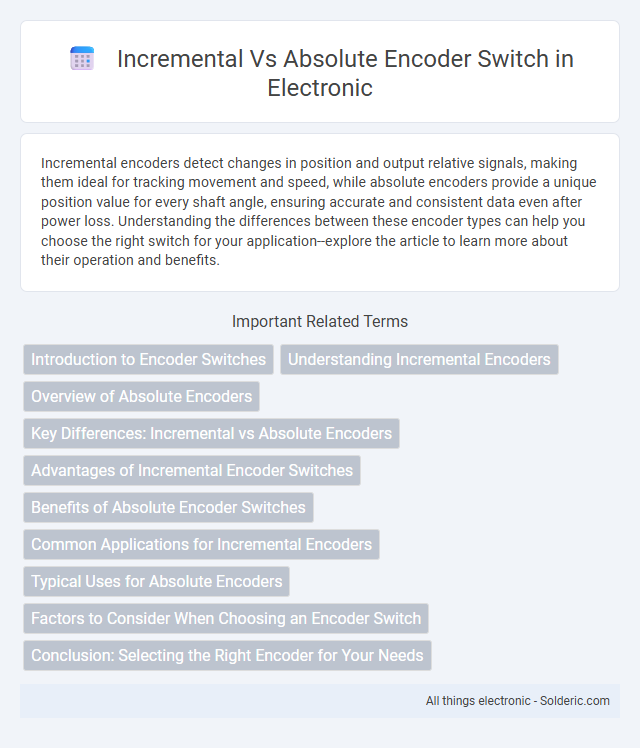Incremental encoders detect changes in position and output relative signals, making them ideal for tracking movement and speed, while absolute encoders provide a unique position value for every shaft angle, ensuring accurate and consistent data even after power loss. Understanding the differences between these encoder types can help you choose the right switch for your application--explore the article to learn more about their operation and benefits.
Comparison Table
| Feature | Incremental Encoder Switch | Absolute Encoder Switch |
|---|---|---|
| Position Measurement | Measures relative position changes | Provides exact position value |
| Signal Output | Pulses corresponding to movement increments | Unique digital code for each position |
| Power Loss Impact | Position data lost on power off | Retains position data without power |
| Cost | Lower cost, simpler design | Higher cost, complex design |
| Application | Best for speed and direction sensing | Ideal for absolute position tracking |
| Accuracy | Dependent on external counters and references | High accuracy with direct position readout |
Introduction to Encoder Switches
Encoder switches play a critical role in converting mechanical motion into electrical signals for precise position tracking. Incremental encoders generate pulses relative to movement, enabling relative position measurement and speed control, while absolute encoders provide a unique digital code for each shaft position, ensuring exact position knowledge immediately upon startup. Your choice between incremental and absolute encoder switches depends on the application's requirements for position accuracy, initialization time, and system complexity.
Understanding Incremental Encoders
Incremental encoders generate pulse signals corresponding to movement increments, allowing precise measurement of position changes and velocity in real-time control systems. They lack absolute position data, requiring a reference point or homing procedure to establish the initial position after power loss. These encoders are widely used in applications needing relative motion feedback, such as robotics and CNC machinery.
Overview of Absolute Encoders
Absolute encoders provide precise position data by assigning a unique code to each shaft position, ensuring exact angle measurement even after power loss. Unlike incremental encoders that track movement relative to a starting point, absolute encoders deliver a definitive shaft position instantly upon startup. Using an absolute encoder switch enhances your system's reliability by eliminating the need for homing sequences and reducing downtime.
Key Differences: Incremental vs Absolute Encoders
Incremental encoders provide relative position information by generating pulses as the shaft rotates, requiring a reference point to determine exact position, while absolute encoders deliver unique position values directly through a coded output for precise tracking. You rely on incremental encoders when counting rotation increments or speed, whereas absolute encoders are essential for applications demanding exact position feedback even after power loss. The key differences in output data format, position accuracy, and system complexity influence your choice between incremental and absolute encoder switches.
Advantages of Incremental Encoder Switches
Incremental encoder switches offer advantages such as simpler design, lower cost, and easier integration in motion control systems compared to absolute encoders. They provide high-resolution feedback with fewer wiring requirements and faster response times for position and speed detection. Incremental encoders are ideal for applications requiring relative position tracking and real-time speed monitoring.
Benefits of Absolute Encoder Switches
Absolute encoder switches provide precise position tracking by offering unique position data for each shaft angle, eliminating loss of reference during power outages. Their non-volatile memory ensures continuous accuracy without needing a return-to-zero calibration, enhancing system reliability. You benefit from improved performance in applications requiring exact positioning and consistent feedback.
Common Applications for Incremental Encoders
Incremental encoders are commonly used in applications requiring precise motion control and speed measurement, such as robotics, conveyor systems, and CNC machines. Their ability to provide real-time position feedback by generating signals in response to motion makes them ideal for tracking shaft rotation and detecting changes in position. You can rely on incremental encoders for tasks where relative movement tracking and speed monitoring are essential.
Typical Uses for Absolute Encoders
Absolute encoders are typically used in applications requiring precise position tracking and immediate feedback after power loss, such as robotics, industrial automation, and CNC machinery. They provide unique position values for each shaft angle, ensuring accurate and reliable measurements without the need for reference homing. This makes them ideal for systems where position accuracy and repeatability are critical for performance and safety.
Factors to Consider When Choosing an Encoder Switch
Choosing between incremental and absolute encoder switches depends on factors such as required position accuracy, memory retention, and cost efficiency. Incremental encoders offer high resolution and speed for applications needing relative position data, while absolute encoders provide unique position values even after power loss, essential for complex automation systems. Environmental conditions, installation complexity, and compatibility with existing control systems also influence the optimal encoder switch selection.
Conclusion: Selecting the Right Encoder for Your Needs
Choosing between incremental and absolute encoders depends on your application's precision and reliability requirements. Incremental encoders offer cost-effective position feedback with relative measurements, ideal for applications needing rapid changes and simple control. Absolute encoders provide exact position data even after power loss, ensuring accuracy and reducing downtime in critical or complex systems.
incremental vs absolute encoder switch Infographic

 solderic.com
solderic.com